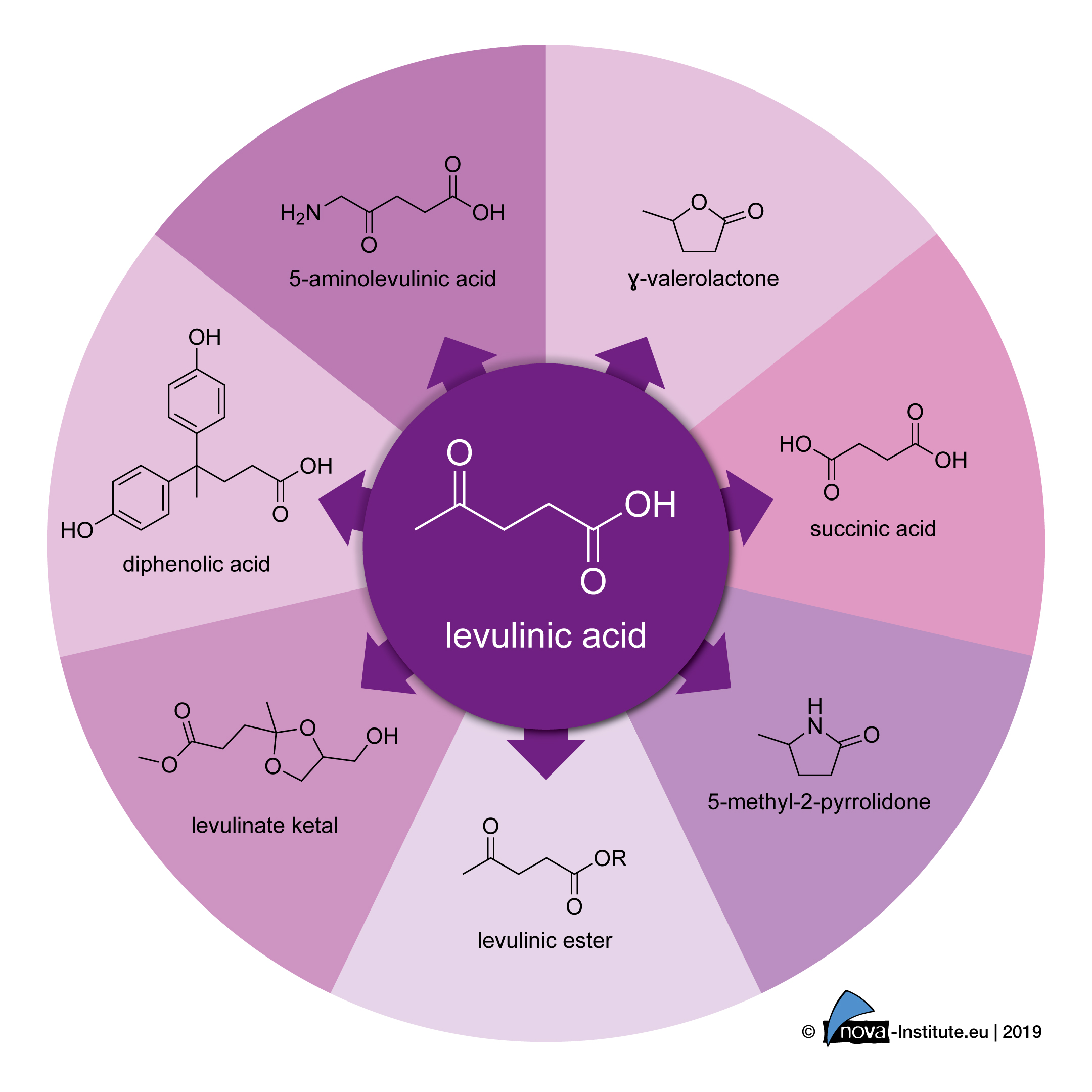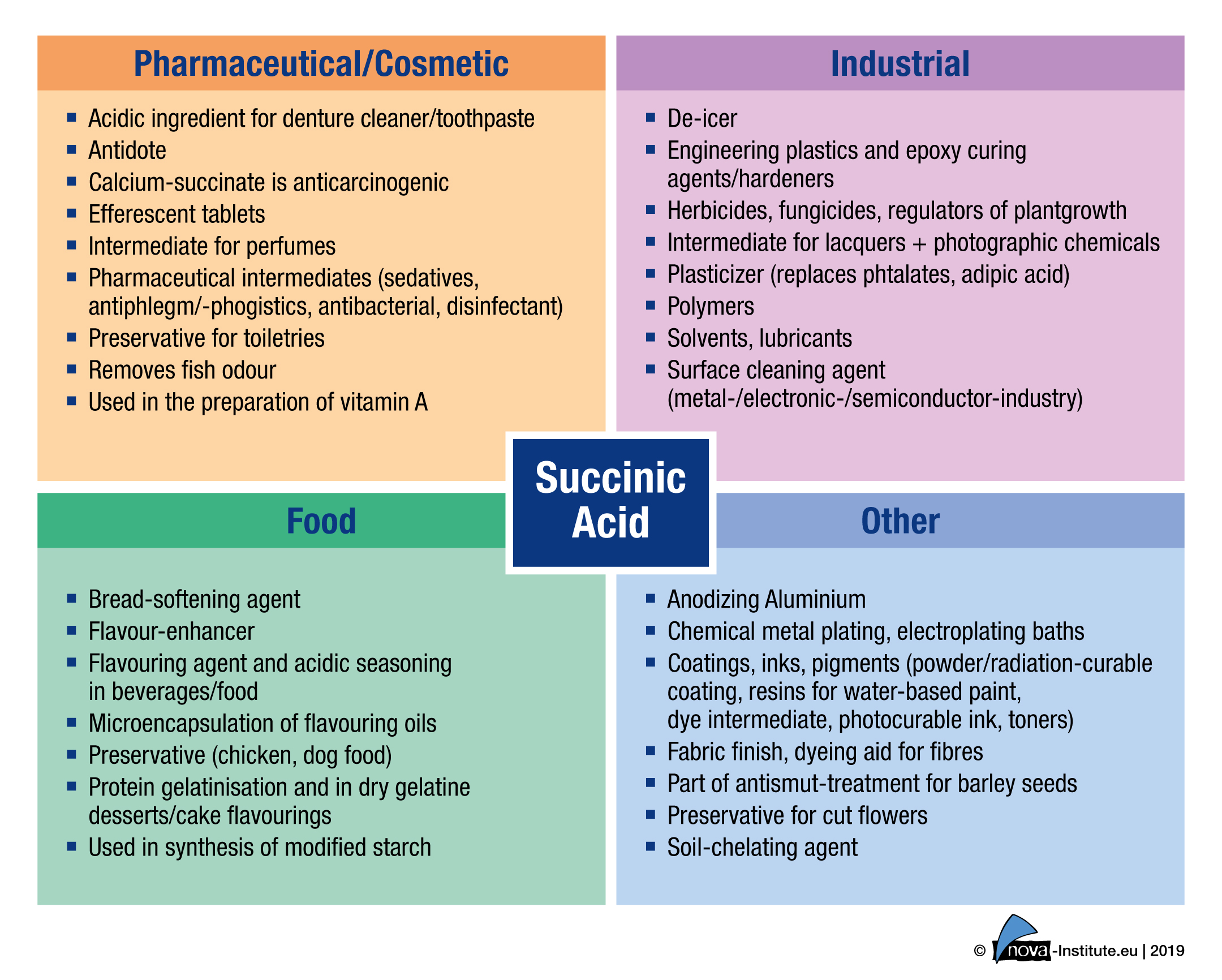Both chemicals, levulinic and succinic acid, were selected twice as promising bio-based building blocks for the chemical industry. While a strong hype pushed exaggerated market expectations for succinic acid, levulinic acid developed in secret.
Deutsche Fassung: https://renewable-carbon.eu/news/?p=67432
Two new market reports published by nova-Institute shed light on the current and future market situation of these previously acclaimed promising bio-based building blocks. A comprehensive and especially realistic view on the production and market potential of both bio-based building blocks compared to their fossil-based counterparts is given. Although both still have a high chemical potential, they have fallen short of technology and market demand expectations. Current market data combined with ongoing technology development and an expected decrease of oil prices has led to a new carefully estimated future market growth for both levulinic and succinic acid.
The report on “Levulinic acid – A versatile platform chemical for a variety of market applications – Global market dynamics, demand/supply, trends and market potential” clearly shows that production technology and market demand of levulinic acid has not yet developed according to previous expectations. The promised low-cost direct production from biomass is still under development, leaving room for several possibilities of further development. The market report discusses the future development under proper technological conditions.
“Succinic acid: From a promising building block to a slow seller – what will a realistic future market look like?” covers the value chain of the succinic acid market, the technologies involved in the succinic acid production and its biomass utilisation efficiency. Apart from the most appropriate applications, also market demand estimates, the key drivers and inhibitors are discussed in detail by the report. The significant gap between previous estimations and the current market situation is discussed and explained by the market study; highlighting room for growth and the necessary framework conditions.
Levulinic acid
Levulinic acid is bearing two different reactive functional groups making it a versatile intermediate for the synthesis of a large number of derivatives.
Its versatility and potential low production cost when produced directly from biomass are the reasons for the Department of Energy (DoE, USA) to select levulinic acid as one of the most promising bio-based building blocks for the fuel and chemical industries in 2004 and in 2010.
However, the production technology and market demand of levulinic acid has not yet developed according to previous expectations. Its direct production from biomass is still under development, being the current production mainly based on furfuryl alcohol, which makes it rather expensive.
Direct production of levulinic acid from biomass has the potential to reduce production costs significantly, which is expected to create additional demand for all current market segments. Apart from that, it is expected that new market segments will open due to the potential of its derivatives, specially and among others: levulinic esters, methyltetrahydrofuran (MTHF), γ-valerolactone (GVL), diphenolic acid (DPA), oligomers for transport fuels and levulinic acid derived ketals.
For those markets, a driver for change will be a combination of additional performance and price. Product availability and security of supply are also important decision factors for change.
When taking into account that time is needed for product development, market introduction and up-scaling of production, a doubling of market demand in five years is carefully estimated, provided that the production technology from biomass is in place.

Succinic acid
The research on succinic acid shows a clear mismatch between the supply and demand estimates. This was already visible in last year’s market report and the trend has not changed. The interest for bio-based succinic acid grew after its production was forecasted to become cost competitive with fossil-based succinic acid, inspiring a lot of hope for such a business case in the last few years. However, these projections were based on crude oil price assumptions that did not come true, with the oil price staying below the projected levels. The market for fossil-based succinic acid always remained small with a primary focus on specialty chemicals that now can be served via bio-based succinic acid. This seems to stay the same. Also the expected rise in demand for 1,4-butanediol, which was considered a key market for bio-based succinic acid, did not become reality due to the same price considerations. It is not expected that any production units for 1,4-butanediol from bio-based succinic acid will become commercial before 2023.
This is the clear reason why several companies had to close down their operations to produce bio-based succinic acid. The shutdown also caused a rise in price levels of succinic acid.
On the other hand, compared to the past, today the production of succinic acid for niche applications and specialities is strongly focused on the bio-based routes through the fermentation of glucose from bio-based feedstock and downstream purification of the raw acid. The first commercial fermentation facilities have been running since 2012 and the production is rising on a smaller level than expected but on higher prices. The current research looks into different applications, like the bio-based polymer polybutylene succinate (PBS) and coatings that will be the main drivers for succinic acid growth until the end of 2023. However, the succinic acid market is expected to be confined to specialty applications at least until the end of 2023. Larger commodity markets will strongly depend on the crude oil price development and the market report highlights these potential developments.

As usual, nova market studies are built on top insights from market experts, painstaking research and a large number of one-on-one interviews with industry players to ensure the best quality of market data available.
The market reports are now available for 1,750 € each at http://bio-based.eu/reports/ – in addition to further market studies on different topics of bio- and CO2-based economics.
Press release as PDF file and graphics: http://nova-institute.eu/press/?id=146
Source
nova-Institute, press release, 2019-10-09.
Supplier
nova-Institut GmbH
US Department of Energy (DoE)
Share
Renewable Carbon News – Daily Newsletter
Subscribe to our daily email newsletter – the world's leading newsletter on renewable materials and chemicals









